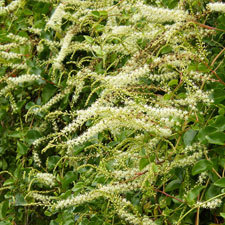 Mignonette vine
Mignonette vine
Common name: Mignonette vine; Madeira vine
Botanical name: Anredera cordifolia
Management category: Advisory
Originally from South America. It was introduced to New Zealand as an ornamental species and was recorded as naturalised in 1940.
Why is it a pest?
- Its tubers are very hard to kill and salt-water tolerant.
- It grows at a moderate rate and forms heavy, long-lived masses.
- Smothers all plants in the canopy and can topple trees.
- Prevents the establishment of native seedlings.
Where is it found?
Widespread in coastal Bay of Plenty, particularly in warmer areas. It is found in low and disturbed forest and margins, gullies, shrublands, coastline, river systems and streamsides.
What does it look like?
- Perennial, evergreen climbing, hairless woody vine with fleshy rhizomes and usually reddish stems with small irregular ‘warty’ aerial tubers.
- Spreads via the tubers which detach very easily.
- Fleshy to succulent bright green heart-shaped leaves that are glossy, clammy to the touch, and arranged alternately on the stems.
- Slender drooping flowerheads (up to 18cm long) of small, numerous, fragrant cream flowers are produced from January to April but no fruit is formed.
What are the rules?
Advisory
Council does not enforce the control of advisory species. It is landowner/occupier responsibility to manage these pests. Council may provide advice on how to manage or control advisory species if required.
How do you get rid of it?
- Dig out (all year round), incinerate plant or place in black plastic bag and leave to ‘cook’ in sun for an extended period. Ensure all the tubers are removed.
- Cut and Paste (all year)
- Spraying (Spring to Autumn)
CAUTION: When using any herbicide or pesticide, PLEASE READ THE LABEL THOROUGHLY to ensure that all instructions and directions for the purchase, use and storage of the product, are followed and adhered to.
Read more on pest control advice, information and regulations.
Images







